List AND describe the properties of neurons
Excitability (irritability)–ability to respond to changes in the body and external environment called stimuli
Conductivity–produce traveling electrical signals
Secretion–when electrical signal reaches end of nerve fiber, a chemical neurotransmitter is secreted
What are the major functions of the human nervous system?
Neurons - The basic functional units of the nervous system – the communicators!
Supporting cells
1.) CNS (central nervous system) - neuroglia (glial cells)
Astrocytes, microglia, ependymal cells, oligodendrocytes
2.) PNS (peripheral nervous system)– satellite cells, Schwann cells
CNS- Central Nervous System
Structural and functional center of the entire nervous system.
Consists the brain and spinal cord
Integrates(combines) incoming pieces to sensory information, evaluates the information, and initiates an response.
PNS- Peripheral Nervous System
Consists of the nerve tissues that lie in the periphery or "outer regions" of the nervous system. Fibers extending away from the CNS.
Which are the two major types/groups of cells that make up nervous tissue?
Neurons and Neuroglia
What are the four neuroglia of the CNS?
1. Astrocytes
2. Oligodendrocytes
3. Microglia
4. Ependymal
Two neuroglia of the PNS?
1. Satellite Cells
2. Schwann Cells
Label the structures found in a neuron AND describe their functions

Function of Dentrites
RECIEVE
Highly branched SEND electrical signal toward the cell body
Dendritic spines:
–many fine processes
–receive information from other neurons
–80–90% of neuron surface area
Function of Axon
AWAY
Conduct electrical impulses away from the cell body
Only one per neuron
Carries electrical signal (action potential) to target
Axon structure is critical to function
Axoplams
Cytoplasm of axon
Contains neurotubules, neurofibrils, enzymes, organelles
(Axoplams) What was the cytoplasm around the nucleus called?
Perikaryon
Axolemma
–specialized cell membrane
–covers the axoplasm
Axon Collaterals
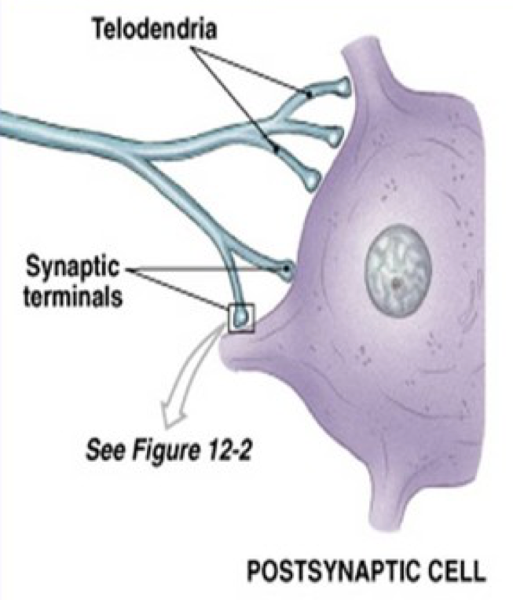
branches of a single axon
Axon telodendria
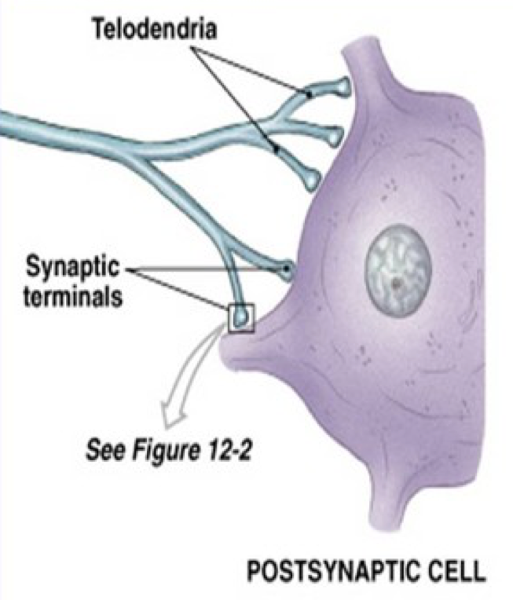
fine extensions of distal axon
Synaptic terminals
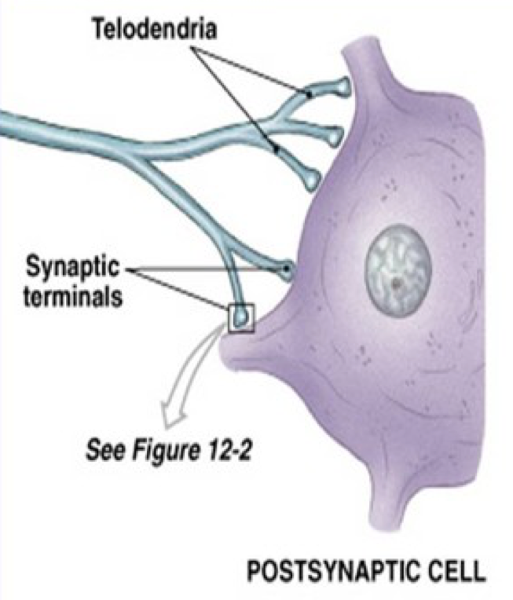
tips of axon
What is myelin and what is its primary function?
Primary function-Increases the speed of transmission of nerve impulses (up to 150 times faster)
Serves to protect and electrically insulate axon
Whitish, fatty protein layer (20% protein and 80 % lipid)
Only associated with axons, not dendrites
All myelination completed by late adolescence
Along the axons of myelinated neurons there are gaps in the myelin where the axolemma is exposed. What is the name given to these gaps in myelin?
Nodes of Ranvier
Describe how a nerve is “bundled.”
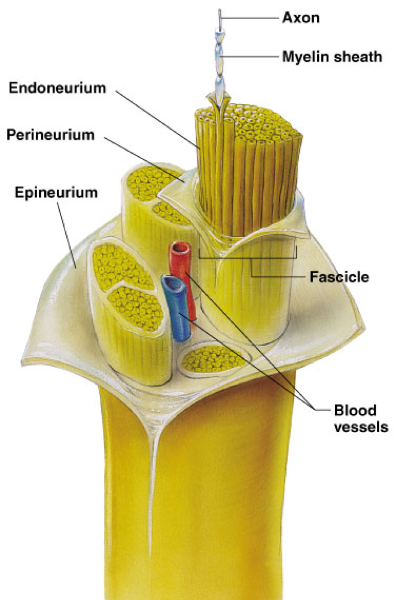
Endoneurium surrounds each fiber
Groups of fibers are bound into fascicles by perineurium
Fascicles are bound together by epineurium
Explain the pathophysiology of Multiple Sclerosis (MS).
It is characterized by myelin loss and destruction accompanied by varying degrees of oligodendrocytes injury and death. As the myelin surrounding nerve fibers is lost, nerve conductions is impaired and weakness, loss of coordination, visual impairment, and speech disturbances.
- Autoimmune
- Oligodendrocytes and myelin sheaths of CNS degenerate
- Replaced by hardened scar tissue
- Between 20-40 yrs
- Double vision, blindness, speech defects, neurosis, tremors, numbness
- Variable cycles until bedridden
- No Cure
What is the name of the cell whose function is to connect neurons to blood capillaries?
Astrocytes
What is the function of satellite cells found in the PNS?
Protect neuron cell bodies
Which cell of the CNS is responsible for circulating cerebrospinal fluid in the major cavities of the brain and spinal cord?
Ependymal cells
What is the function of microglia?
Dispose of debris in areas of infection, trauma or stroke
Which type of ciliated cell lines the ventricles of the brain, producing and circulating CSF?
Ependymal cells
Which cells form myelin in the PNS? Which cells form myelin in the CNS?
In the PNS, the Schwann cells form myelin.
In the CNS, the
Oligodendrocytes form myelin
Describe the relationship of sodium and potassium concentrations inside and outside of the cell with the resting membrane potential.
Na+ concentrated outside of cell (Extracellular Fluid)
K+
concentrated inside cell (Intracellular Fluid)
Answer the following review questions regarding action potential generation and propagation:
What happens during threshold?
***If threshold potential (-55mV) is reached voltage-gated Na+ channels open (Na+ enters causing depolarization)
The action potential is an explosion of electrical activity that is created by a depolarizing current. This means that some event (a stimulus) causes the resting potential to move toward 0 mV. When the depolarization reaches about -55 mV a neuron will fire an action potential. This is the threshold.
Answer the following review questions regarding action potential generation and propagation:
What ion is responsible for depolarization?
(Na+ enters causing depolarization)
Answer the following review questions regarding action potential generation and propagation:
What ion is responsible for repolarization?
K+
Slow K+ gates fully open
K+ exits repolarizing the cell
Answer the following review questions regarding action potential generation and propagation:
What is the cause of hyperpolarization?
Negative overshoot produces
hyperpolarization
–excessive exiting of K+
Answer the following review questions regarding action potential generation and propagation:
What is the sodium-potassium pump, and why is it so important to nerve impulse transmission?
Sodium potassium pump is a mechanism in the plasma membrane actively pumps sodium ions (Na+) out of the neuron and potassium ions (K+) into the neuron. This occurs at an unequal rate. 3 sodium ions out and 2 potassium ions in. Because very little sodium reenters the cell via diffusion, this maintains an imbalance in the distribution of ions and thus maintains the resting potential.
Answer the following review questions regarding action potential generation and propagation:
How many Na and K ions does the Na/K pump move and in what direction do these two ions move?
3 Na+ out
2 K+ in
Answer the following review questions regarding action potential generation and propagation:
Explain what nondecremental means.
nondecremental (do not get weaker with distance)
Answer the following review questions regarding action potential generation and propagation:
Explain why an action potential is irreversible in terms of ion channels
–irreversible (once started goes to completion and can not be stopped)
Answer the following review questions regarding action potential generation and propagation:
Compare and contrast absolute refractory period and relative refractory period. Which one of these two is it possible for another action potential to occur?
Absolute refractory period
–as long as Na+ gates are open
–NO stimulus will trigger AP
Relative refractory period
–as long as K+ gates are open
–***only especially strong
stimulus will trigger new AP
Answer the following review questions regarding action potential generation and propagation:
Describe the effect of the diameter of an axon on impulse transmission speed.
Diameter of fiber presence of myelin
large fibers have more surface area for signals
think of a larger diameter pipe having less resistance than a smaller pipe
Myelinated faster than unmyelinated
Answer the following review questions regarding action potential generation and propagation:
Compare and contrast impulse transmission in an unmyelinated axon with impulse transmission in a myelinated axon. Make sure to use the term salutatory conduction in your response.
Transmission is faster in myelinated axon. The myelinated axon is considered the Salutatory conduction. Fast signals supply skeletal muscles and transport sensory signals for vision and balance.
Transmission is slower in the unmyelinated axon. Slow signals supply the stomach and dilate the pupil.
Answer the following review questions regarding action potential generation and propagation:
Explain how it is possible in a myelinated axon for action potentials to occur at only the Nodes of Ranvier. In other words, what causes the action potential to occur at each of the Nodes of Ranvier?
...
At rest, a neuron's membrane potential is typically maintained at about what?
-70 mV
Explain each step involved in the transmission of an impulse from an axonal terminal across a synapse to the receptor membrane of a dendrite. You probably want to draw out the steps. Make sure to keep your ions straight, especially the roles of calcium and sodium. This one should take you some time!
...
Compare and contrast, in detail, iontropic receptors and metabotropic receptors. IONTROPIC RECEPTOR
Also called a ligand – gated receptor
No second messenger is involved
Think ion = direct effect on channel
Compare and contrast, in detail, iontropic receptors and metabotropic receptors. METABOTROPIC RECEPTORS
?????
Classify the major receptor types that we use to “sense the world around us” as iontropic or metabotopic.
Inotropic sensory receptors- Mechonoreceptor, Thermoreceptor, Electroreceptor
Metabotropic- Chemoreceptor, Photoreceptor
What are the four types of neurotransmitters?
Acetylcholine - formed from acetic acid and choline
Amino acid neurotransmitters
Monoamines
Neuropeptides
List AND describe the two classes of neurotransmitters.
1.Excitatory neurotransmitters:
–cause depolarization of postsynaptic membranes
–promote action potentials
2.Inhibitory neurotransmitters:
–cause hyperpolarization (goes in opposite direction of depolarization) of postsynaptic membranes
–suppress action potentials
Compare and contrast the events related to IPSP’s and EPSP’s. In other words, what is happening on the postsynaptic cell with each of these?
IPSP = inhibitory postsynatic potential
–NT causes postsynaptic membrane to become more permeable to Potassium (moves out) OR Chloride (moves in)
EPSP = excitatory postsynaptic potential
–NT causes opening of more ligand gated Sodium channels on postsynaptic membrane
Explain the difference between temporal and spatial summation. You probably want to draw and graph of each of them. SPATIAL SUMMATION
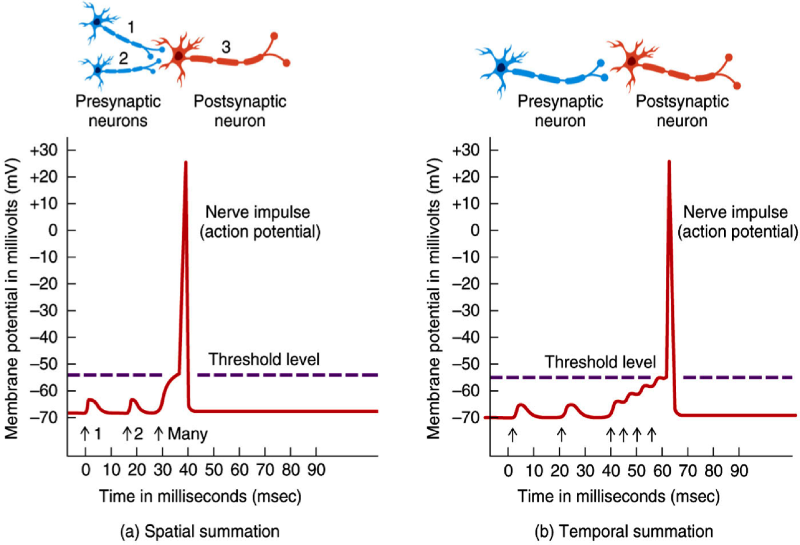
When several knobs are activated simultaneously, neurotransmitters stimulate different locations on the postsynaptic membrane. these local potentials may spread far enough to reach the axon hillock, where they add together, or summate. If the sum of the local potentials reach the threshold potential, voltage gated channels in the membrane open, causing an action potential.
Explain the difference between temporal and spatial summation. You probably want to draw and graph of each of them. TEMPORAL
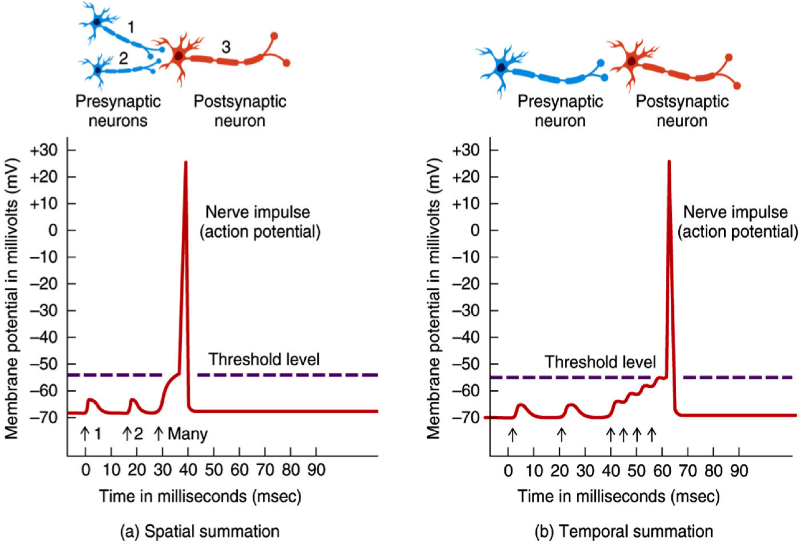
When synaptic knobs stimulate a postsynaptic neuron in rapid succession, their effects can add up over a brief period of time to produce an action potential.
What is the significance of “synaptic delay?” What type of synapse is synaptic delay not really an issue? Explain!
*A synaptic delay of 0.2–0.5 milliseconds occurs between:
–arrival of action potential at synaptic knob
–and effect on postsynaptic membrane
*Rate limiting factor in transmission of a nerve impulse
*Not as much of a factor in an electrical synapse
–Allow ions to pass between cells
–Produce continuous local current and action potential propagation
–Are found in areas of brain, eye, ciliary ganglia
Diagram the excitatory cholinergic synapse. Make sure to include the role of acetylcholinesterase!
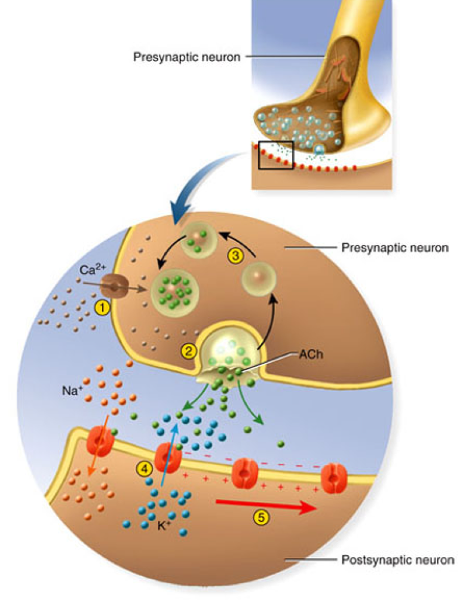
- Nerve signal opens voltage-
gated calcium channels
in synaptic knob - Triggers release of ACh which
crosses synapse - ACh receptors trigger opening
of Na+ channels producing
local potential (postsynaptic
potential) - When membrane reaches threshold, triggers AP
in postsynaptic neuron
Explain what would happen if acetylcholinesterase where inhibited.
If acetylcholinesterase activity is inhibited, the synaptic concentration of acetylcholine will remain higher than normal. If this inhibition is irreversible, as in the case of exposure to many nerve gases and some pesticides, sweating, bronchial constriction, convulsions, paralysis, and possibly death can occur. Although irreversible inhibition is dangerous, beneficial effects may be derived from transient (reversible) inhibition. Drugs that inhibit acetylcholinesterase in a reversible manner have been shown to improve memory in some people with Alzheimer's disease.
Diagram the GABA-ergic synapse. Make sure to include what ion is involved on the postsynaptic membrane.
...
Explain how some common drugs affect the GABA-ergic receptor on the postsynaptic membrane.
Alcohol is one of the depressant drugs in widest use, and is believed to cause its effects by interacting with the GABA receptor. Initially anxiety is controlled, but greater amounts reduce muscle control and delay reaction time due to impaired thinking.
Explain how neurotransmitter reuptake inhibition affects the synapse
Neurotransmitter is recycled back into presynaptic
neuron
Synapse more active when 5-HT (Serotonin) reuptake is
blocked by an SSRI (Serotonin Specific Reuptake Inhibitor)
Explain the role of MAO (Monoamine Oxidase) on neurotransmitters that have been reabsorbed into the presynaptic cell. What happens if this enzyme is blocked?
Neurotransmitter is sometimes broken down into smaller pieces once it
is taken back into the presynaptic neuron
An enzyme, monoamine
oxidase breaks down many types of NT's
Some old antidepressant
drugs (called MOAI's) inhibit this enzyme increasing availability of
some NT's involved with depression